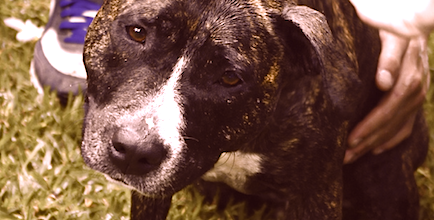Don’t Underestimate the Power of the Physical Exam for Your Pet
If you think your pet is in pain, don’t try to guess at the cause — bring them to the vet.

Ultrasounds, CT scans, MRIs, telemedicine consults, genetic testing — we’ve come a long way.
While vets can offer our pet patients a world of advanced medicine and technology, don’t underestimate the oldest tool out there: a physical exam for your pet.
There is nothing more satisfying to me, a veterinarian, than my laying on of hands to begin an evaluation and a diagnosis of a patient.
I’m not talking about religious or energy healing here, although every bit of that helps. No, I’m referring to what a vet can learn by conducting a complete physical examination, face-to-snout and hand-to-paw.

Don’t leave your pet’s safety to chance
Sign up for Petful recall alerts today.

Physical Exam for Your Pet
The significance of the physical state of things is in a bit of jeopardy in this brave new world of ours.
More and more importance is being placed on learning new technologies in veterinary school.
Are vet schools turning out young vets who dismiss the importance of the exam in place of using fancy technology? Do veterinarians still trust and respect the power of the physical exam?
In human medicine, many patients complain their doctor never looks up from a computer. Is the art of the physical exam losing integrity, respect and — ultimately — importance?
Many people think so. But at least a human can walk into a doctor and voice a complaint: “My stomach hurts” or “My chest is tight.”
My patients can’t do that. The physical exam is our starting point to figure out what ails the pet.
The Good Old Physical Exam
Examples are swirling in my head of why a few minutes of exam time with an actual animal in front of me is worth its weight in diagnostic gold. Nothing replaces this.
I start at the top.
One of the first things I examine is the color and quality of the gums in the mouth. I pick up the soft muzzle and look at the animal’s gums (mucous membranes).
A careful assessment is a window into the animal’s health status. For example, people have a tough time assessing gum color. It’s a skill that comes with looking at hundreds of fuzzy mouths.

Case #1
A client called and wanted to speak to me over the phone before bringing in her cat, who wasn’t eating.
Bonkers had been seen several times in the last year because he was 16 and developing some health problems.
His human explained vague signs of inappetence and lethargy. Blood work taken several months ago had been normal. She thought there was nothing too seriously wrong and wanted an appetite stimulant.
I didn’t like how this sounded and urged her to bring Bonkers in. One look at Bonkers’ gums and sclera, and it was clear I had a yellow cat in front of me. When the mucous membranes in the mouth and/or the whites of the eyes look yellow-tinged, the cat is jaundiced.
Jaundiced cats just get sicker and sicker without medical intervention. An early physical exam gave Bonkers the best chance of early treatment and survival. Talking on the phone would never have been enough.
Case #2
Yoda is a sage, old dog, and his human called one day, saying he just didn’t want to go out for his usual short walks this week.
She believed his arthritis was acting up and wanted a refill of his arthritis medication. The receptionist recommended a visit.
One look at Yoda’s gums was enough to sound the alarm bell.
His gums were very pale, something the person couldn’t see. Yoda was very anemic and was losing blood. Palpating his abdomen revealed more bad news: I could feel a mass, and it had probably begun to bleed.
Yoda showed no indication of how sick he was to his human. That first 60 seconds of his physical exam provided invaluable information.
Phone Consult vs. Physical Exam for Your Pet
Procuring a veterinary consult over the phone before you visit a veterinarian in the flesh really bothers me.
No matter how adept you think you are at explaining your pet’s symptoms in writing or on the phone, it is highly possible you are missing the most important clue to your pet’s problem that a veterinarian can pick up only in a physical exam.
Call-in vet advice shows are fine for gathering information, and most vets helping people in this way almost always suggest you take your pet to a vet.
But some vets charge for actual consults over the phone in place of a visit — this can put your pet in danger if a diagnosis is missed or a misdiagnosis is given over the phone.
Here’s one vet’s take on a physical exam for a dog:

Let the Patient Speak
A good veterinarian never underestimates the physical exam. The physical allows the observant vet to pick up the silent, subtle cues from that animal.
- What are those eyes really expressing? Pain? Confusion? Peace?
- What does that stance mean? Pain in the abdomen or in the spine?
- Is the pet panting from excitement, pain or difficulty breathing?
A pet can show me so much just in the way they walk in the door and approach me.
Dr. Patty Khuly, VMD, agrees, saying, “No test, no matter how sophisticated, is quite so crucial to your pet’s health as a full physical exam.”
Before running a battery of tests right off the bat, I’ve learned to sit with my patient for a few extra minutes and let them “tell” me where it hurts.
Technology will never replace instinct.
How Much Time Will a Physical Exam Take?
“Some vets are fast and thorough, others are slow and sloppy,” explains Dr. Khuly. “The vast majority of us fall somewhere in between.”
She adds: “Either way, speed (or lack thereof) does not make for a good exam. It’s more about thoroughly covering all the bases, picking up on historical and physical cues, and knowing where to pause to make sure we heard, saw or smelled that right.”







